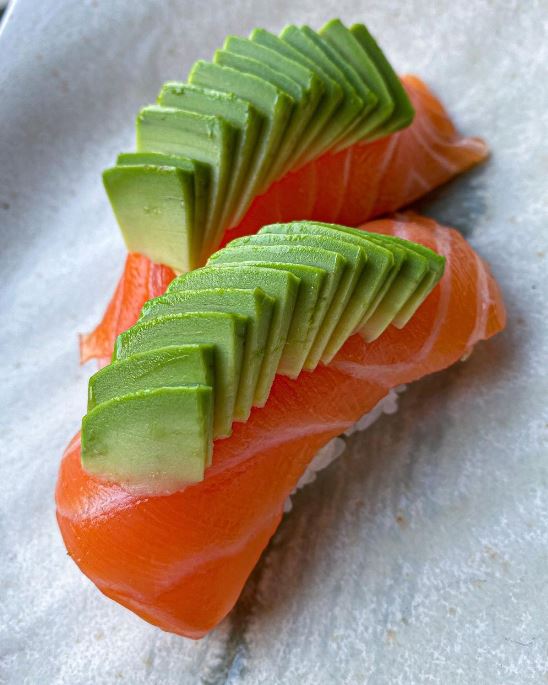Salmon Avocado Sushi Recipe: A Comprehensive Guide to Making the Perfect Sushi Roll
Sushi is a traditional Japanese dish that has gained immense popularity all over the world. The combination of succulent salmon and creamy avocado is a match made in heaven and is perfect for those who are looking for a healthy, delicious and easy-to-make meal. In this article, we’ll take you through a step-by-step guide to making the perfect salmon avocado sushi roll.
Ingredients
- 1 cup of sushi rice
- 2 tablespoons of rice vinegar
- 1 teaspoon of sugar
- 1 teaspoon of salt
- 2 ripe avocados
- 4 ounces of salmon fillet
- 4 sheets of nori seaweed
- Wasabi
- Soy sauce
Preparation
Step 1: Cooking the Rice
The first step in making sushi is to cook the rice. To do this, rinse 1 cup of sushi rice in cold water until the water runs clear. Then, transfer the rice to a medium saucepan, add 1 and 1/2 cups of water, and bring it to a boil. Reduce the heat to low, cover the saucepan and let the rice cook for 18-20 minutes. Once the rice is cooked, remove it from heat and let it cool.
Step 2: Seasoning the Rice
While the rice is cooling, prepare the seasoning. In a small saucepan, mix together 2 tablespoons of rice vinegar, 1 teaspoon of sugar, and 1 teaspoon of salt. Heat the mixture over low heat until the sugar and salt have dissolved.
Once the rice has cooled, transfer it to a large mixing bowl. Pour the seasoned vinegar mixture over the rice and mix it in thoroughly. Let the rice cool to room temperature.
Step 3: Preparing the Avocado and Salmon
Slice the avocados in half, remove the pit, and cut the flesh into thin slices. Cut the salmon fillet into thin slices as well.
Step 4: Assembling the Sushi Roll
Place a sheet of nori seaweed shiny-side down on a bamboo sushi mat. Spread a thin layer of the seasoned rice over the nori, leaving a 1-inch border at the top.
Place the salmon and avocado slices in a line across the center of the rice. Roll the bamboo mat to form a tight cylinder, using the border of rice at the top to seal the roll.
Repeat the process with the remaining nori sheets, rice, salmon, and avocado to make 4 sushi rolls in total.
Serving and Presentation
To serve the sushi, use a sharp knife to cut each roll into 6-8 pieces. Serve the sushi with a small dish of wasabi and soy sauce on the side for dipping.
Conclusion
Salmon avocado sushi is a delicious and healthy meal that is easy to make at home. With the right ingredients and a little bit of preparation, you can enjoy this delicious dish in the comfort of your own home. Whether you’re a sushi lover or just looking for a new meal to try, this salmon avocado sushi recipe is sure to satisfy.
FAQs
- What are the best types of salmon to use in salmon avocado sushi? A: Sake (salmon) or sockeye salmon are the best types of salmon to use in salmon avocado sushi as they have a higher fat content, which adds flavor and texture to the dish.
- Can I use regular rice instead of sushi rice? A: Regular rice can be used, but it won’t have the same stickiness as sushi rice, which is essential for holding the roll together. Sushi rice is also slightly sweeter and more flavorful than regular rice, which complements the flavors of the salmon and avocado.
- Can I use different types of seaweed instead of nori? A: Nori is the traditional type of seaweed used in sushi rolls, but you can also use other types of seaweed, such as hikari or unagi. However, keep in mind that the flavor and texture may be different from that of nori.
- Is it necessary to let the rice cool to room temperature before assembling the sushi roll? A: Yes, it is important to let the rice cool to room temperature before assembling the sushi roll. If the rice is still hot, it will cause the nori to become soft and make it difficult to roll.
- How long does the salmon avocado sushi keep for? A: Salmon avocado sushi is best enjoyed fresh and should be consumed within 2 hours of being made. If you have any leftovers, store them in an airtight container in the refrigerator and consume them within 24 hours.

